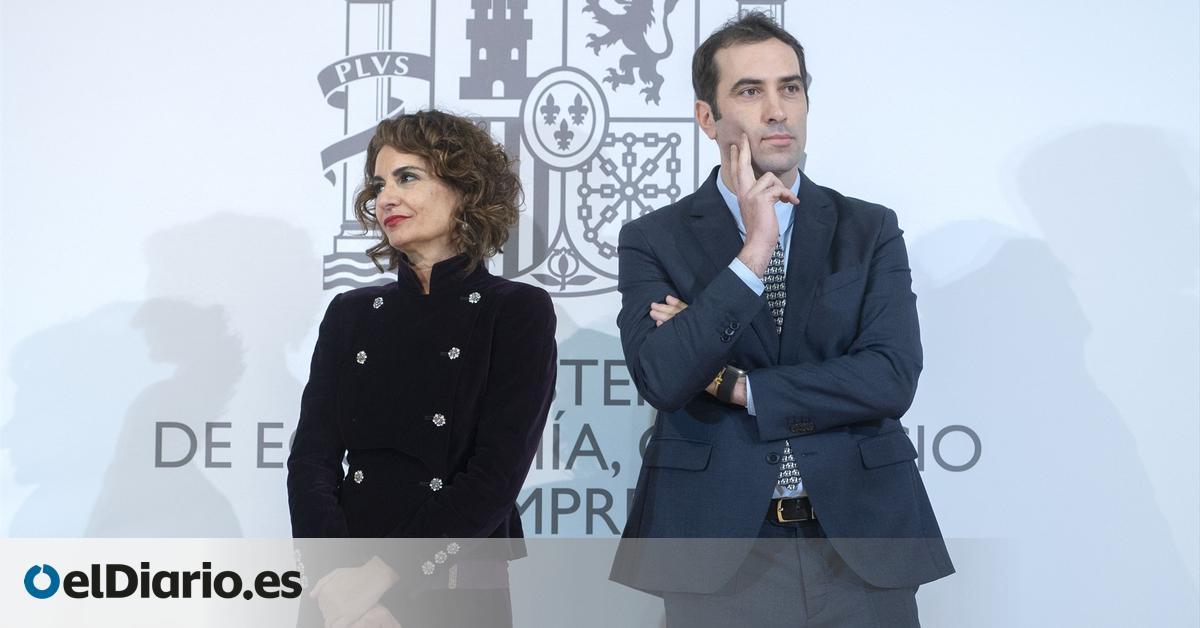
“Your appointment conveys confidence to the markets, to our partners around the world, to institutions, to social agents [empresas y sindicatos] and, of course, to all the Spanish men and women.” The analysis of this appeal from Nadia Calviño to her successor, Carlos Corpo, in the transfer of powers this Friday serves to understand the path that the new Minister of Economy, Commerce and Business is taking.
The economic policy decided by Corps and the rest of the Government’s officials in the matter –María Jesús Montero (Treasury), Teresa Ribera (Energy), Yolanda Díaz (Labor), José Luis Escrivá (Digital)…– must combine the reduction from the deficit to 3% and debt (as required by the new EU taxes) with avoiding another blow of inflation to families and companies (that is, to activity in general) and maintaining strategic investments in the green transition and in digital.
The task is not easy and, given the brake on public spending caused by the fiscal corset that will be released in 2024 (after the previous one was deactivated due to the pandemic), Calviño reminded his replacement (although perhaps it was not necessary) to remain calm to “the markets [que a fin de cuentas son los fondos de inversión, bancos, aseguradoras y particulares de todo el mundo que tienen nuestra deuda pública]” and pleasing partners and institutions (the European Commission, the ECB or the IMF) will be crucial to be able to serve households, companies and the transformations that the current moment demands.
“Carlos Cuerpo is a first-class professional, with great technical solvency, who has great respect and prestige inside and outside of Spain,” Calviño stressed in the same vein. This Friday, Carlos Corpus exactly promised “commitment” to the fair distribution of progress and fiscal “responsibility” to reduce the debt and deficit.
The complexity of the challenge increases if the situation is observed. The new minister inherits an economy that is slowing its growth after completing the recovery from the COVID shock in 2022 and resisting the damage of inflation better than the main European partners from 2021.
The GDP (Gross Domestic Product) will close 2023 with an increase close to 2.5%, “four times more than the eurozone average”, as highlighted by the President of the Government, Pedro Sánchez, this Wednesday, in his balance sheet for the year. , after the last Council of Ministers.
In 2024, Spain will continue to lead growth. But the Executive and, specifically, the economic ministries will be obliged to shore up confidence and protect the two engines of activity, which will be almost exclusively household consumption and business investment, given the weakness of the foreign sector.
Next year, GDP is expected to grow by 1.7%, according to the European Commission. A lower pace than it had been setting since 2021 but which once again stands out in the eurozone. Precisely, the stagnation of the main trading partners means fewer exports and tourism that has reached or is close to reaching its ceiling, and explains a large part of the slowdown in activity as a whole. The forecast models used by the main institutions indicate that for every tenth that European growth contracts, Spain’s growth decreases by another.
The transformations of the economy
In the reconstruction of the pandemic, the evolution of our country’s economy has been highlighted by the unprecedented social response (financing of ERTE, design of the IMV, revaluation of pensions…), and by other measures that have favored structural changes in the labor market (where a record of 21 million people have been hired), in the greater weight of sectors related to innovation and technology and in the growth of service exports (and not just tourism).
Measures and transformations that have protected family incomes and company profits. The increase in the interprofessional minimum wage (SMI), the labor reform, the deployment of the Recovery Plan or the shock plans for inflation are some of the most notable.
The effort in public spending (thanks to the lifting of the previous EU fiscal rules in 2020) has allowed the Government to make these decisions and ensure that family incomes have resisted the damage of inflation (as seen in the graph above) or that company profits exceed pre-COVID levels.
In the opposite sense, it has triggered indebtedness (public debt relative to GDP, already swollen as a consequence of the 2008 financial crisis), which has only been reduced from the maximum of 2020; when it exceeded 120%, due to economic growth, given the high budget deficits (the imbalance between public expenditure and income) of this reconstruction phase (in 2022 it was still 4.7% of GDP, in 2023 it will close close to 4.2%).
Now, the deficit has to be lowered. With more flexible conditions than a decade ago, yes. This path has already been marked by the latest anti-crisis decree, which the Council of Ministers approved this Wednesday and which has cut its cost to 5.3 billion, from 15,000 million in 2023 and 22,000 million in 2022.
For the moment, projections suggest that our country will leave the budget imbalance at the 3% objective in 2024 or that it will exceed it by just a few tenths, and that debt will decrease to 106%, from 107.3% in 2023, according to the Bank of Spain. However, they are high levels that will condition economic policies.
The big problem is that Spain should put among its priorities the reduction of inequality and also the reduction of the high structural unemployment rate (it will continue above 11% next year despite the record number of Social Security affiliates).
Finally, it is an obligation to attend to the investments necessary for the green and digital transition. For the latter, the decisions taken in the EU will be crucial in a context of increased financing costs due to the ECB’s rate increases, return of the fiscal corset and serious geopolitical tensions, with the Russian invasion of Ukraine and the massacre of Palestine as the main sources of concern.
Source: www.eldiario.es

